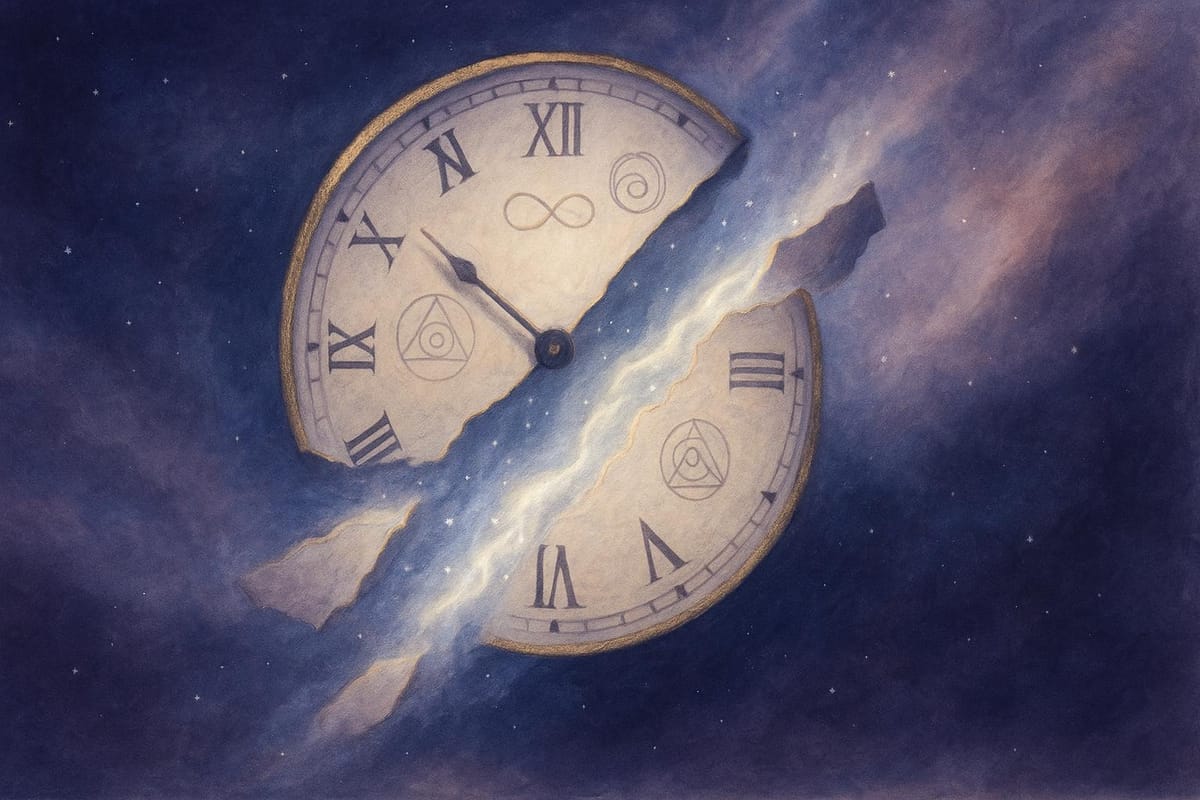What Causes Temporal Glitches?
Explore the causes and implications of temporal glitches, from brain science to quantum physics and simulation theory.

Ever felt like time skipped, twisted, or overlapped? Temporal glitches are strange disruptions in how we perceive time, challenging our usual understanding of reality. These events, like time skips or déjà vu on steroids, can leave us questioning how time really works.
Key Points at a Glance:
-
Types of Temporal Glitches:
- Time Skips: Missing moments with no memory of the gap.
- Concurrent Events: Overlapping realities or experiences.
- Timeline Twists: Events happening out of order.
- Time Travel: Brief, vivid experiences of another era.
-
What Causes Them?
- Brain Factors: Memory, attention, and mental states influence how we process time.
- Quantum Physics: Entanglement and quantum fluctuations may disrupt time perception.
- Simulation Theory: Glitches could be system errors or updates in a simulated reality.
- Energy Fields: Emotional or energetic imbalances might alter time flow.
-
How to Manage Temporal Anomalies:
- Keep a journal of events.
- Practice mindfulness and grounding techniques.
- Use structured time management strategies.
These glitches reveal that time might not be as linear or fixed as we think. Whether it's science, psychology, or metaphysics, each perspective offers clues to understanding these fascinating phenomena.
How Chronostasis and Déjà Vu Simulate Time Travel
Brain Science and Time Perception
The way our brain interacts with time plays a big role in how we experience strange temporal phenomena.
Mental States and Time Distortion
Our mental state can directly influence how we perceive time. For example, a study published in PLoS One found that meditation alters time perception - participants underestimated short intervals but overestimated longer ones. Marlynn Wei, M.D., J.D., sheds light on this:
"If we are attentive and engaged moment to moment, with the same focus, awareness, and alertness that meditation demands, we may be able to experience a fuller and richer sense of the day - and it will, as a result, feel less like 'time got away from us'".
On the other hand, trauma can skew time perception in the opposite direction. Individuals dealing with post-traumatic stress often overestimate time intervals due to disruptions in working memory and attention. These mental shifts highlight how our state of mind sets the foundation for how we process and remember time.
Memory and Time Processing
Memory plays a critical role in shaping how we experience time. Neuroscientist David Eagleman from Stanford University explains:
"The more familiar the world becomes, the less information your brain writes down, and the more quickly time seems to pass".
The brain's ability to process time involves several key areas:
- Prefrontal cortex and hippocampus: Work together to coordinate temporal awareness.
- Suprachiasmatic nucleus: Regulates circadian rhythms, affecting our internal clock.
- Basal ganglia: Handles the processing of shorter time intervals.
During the COVID-19 pandemic, over 65% of participants in a study reported focusing more on the present, while the distinction between weekdays and weekends became blurred. Nina Rouhani, a cognitive neuroscientist, adds:
"Not having specific markers of your past can lead to many external events that trigger trauma-related emotions, generating repetitive, crippling memory".
Working memory, which links new experiences with existing memories, creates what some call the 'psychological thickness' of time. When this process is disrupted, it can make time feel fragmented, leading to sensations like temporal glitches or time slips.
Quantum Physics and Time
The interplay between quantum mechanics and time offers a fascinating glimpse into how temporal anomalies might be explained scientifically. Recent research in quantum physics suggests that these "glitches" in time could have a foundation rooted in quantum principles.
Quantum Effects on Time
Quantum entanglement - a cornerstone of quantum mechanics - challenges traditional ideas about time and causality. Elise Crull, a Philosopher of Physics at CUNY, explains:
"Entanglement is a property of space and time. These separate measurements correlate to a higher degree than we can explain classically".
One intriguing theory, the Page-Wootters (PW) mechanism, suggests that time itself emerges from quantum entanglement between a clock and the system it observes. According to this idea, disruptions in this entanglement could lead to temporal anomalies. Professor Vlatko Vedral from the University of Oxford elaborates:
"Yes, it is mathematically consistent to think of universal time as the entanglement between quantum fields and quantum states of 3D space. However, no one knows if anything new or fruitful will come out of this picture - such as modifications to quantum physics and general relativity, and corresponding experimental tests".
Quantum fluctuations - random energy variations that occur in space - may also play a role in how we perceive time. These fluctuations could explain sudden shifts in temporal perception and pave the way for detecting measurable irregularities in timekeeping.
Time Measurement Anomalies
Several quantum phenomena could influence how we experience and measure time:
| Quantum Phenomenon | Impact on Time | Potential Effect |
|---|---|---|
| Quantum Entanglement | Creates correlations beyond classical physics | May result in non-local time effects |
| Quantum Fluctuations | Involves spontaneous field variations | Could lead to temporal distortions |
Adam Frank from the University of Rochester offers a philosophical perspective on time:
"Maybe the only way to understand time is not from some God's-eye perspective, but from the inside, from a perspective of asking what is it about life that manifests such an appearance of the world".
Quantum time theory suggests that time might not be continuous but instead discrete at the smallest scales. This could explain why temporal anomalies sometimes appear in our daily lives - especially if spacetime itself is quantized and entangled.
Physicist Frank Wilczek captures the essence of quantum activity with this vivid description:
"The primary ingredient of physical reality, from which all else is formed, fills all space and time. Every fragment, each space-time element, has the same basic properties as every other fragment. The primary ingredient of reality is alive with quantum activity. Quantum activity has special characteristics. It is spontaneous and unpredictable".
Simulation Theory and Time Errors
Simulation theory proposes that our reality might be an advanced simulation, where temporal glitches could occur as system errors or intentional updates. This idea blends scientific insights with metaphysical concepts, leading to two intriguing possibilities: shifts in collective memory and programmed changes in time.
Mass Memory Shifts
The Mandela Effect, where large groups of people recall events differently than documented history, is a prime example of mass memory shifts. Supporters of simulation theory interpret these anomalies as potential glitches - either accidental errors or deliberate alterations to the system.
Studies reveal that 76% of people make mistakes when recalling information. Clara Nellist, a particle physicist at CERN, explains the phenomenon:
"I completely get the curiosity and trying to understand the Mandela Effects - people have a strong memory of what they think something was, and then to see a contrast with that memory can be quite jarring".
These memory discrepancies, while fascinating, might only scratch the surface. Simulation theory also suggests that time itself could undergo pre-programmed updates.
Programmed Time Changes
In this framework, glitches are often short-lived and swiftly corrected, much like software patches in technology. Josh Robinson elaborates on this idea:
"Glitches are often temporary occurrences, many times they are rectified within a second, whether it's on a computer, a video game or any other technological device. If we were to be living in a simulation I'd assume the software would be efficient enough to minimize observable errors".
This perspective aligns with the notion that the universe reveals its details only when observed. As Michael Cooper puts it:
"This tells us that there are details of our universe which fundamentally don't exist until we observe them - at the quantum scale, therefore, our universe appears to be procedurally generated, just like the simulated worlds that humans design".
Several observations lend credibility to this interpretation:
- The existence of a universal speed limit resembles processing constraints.
- The fine-tuning of physical constants suggests intentional parameter adjustments.
- The enormous discrepancy in quantum vacuum energy - off by a factor of roughly 10¹²⁰ - could point to computational limitations.
Physicist Brian Greene has speculated that if our reality is indeed a simulation, we might eventually detect inconsistencies in its programming. These potential glitches could offer clues about the computational structure underpinning our universe, though much remains to be uncovered.
Energy Systems and Time Flow
The connection between energy systems and time perception hints that disruptions in both personal and external energy fields might influence how we experience time.
Energy Fields and Time
Just like simulation glitches or quantum irregularities, disturbances in energy fields can lead to time distortions. At the heart of this concept is the Quantum Flux, a subatomic energy field that links matter, enabling shifts in energy, mass, and even the flow of time.
Interestingly, intense emotional states can also alter time perception. Studies using fMRI technology reveal specific brain activity patterns during these moments of temporal distortion. Dr. Maggie Kelly, a Certified Shamanic Energy Healer, explains:
"When your energetic body holds information from the past that hasn't been cleared and is misaligned, the residual effects ripple throughout every aspect of your life".
These disruptions can appear in different forms. For instance, quantum instability might create localized temporal anomalies, while spiritually charged environments can amplify a sense of connection to higher realms. Such shifts in energy might even resonate with experiences that extend beyond the boundaries of this lifetime.
Past Lives and Time Links
Expanding on the effects of energy, imprints from past lives could also play a role in shaping how we perceive time. These imprints might manifest as recurring patterns in our current experiences, reinforcing a cyclical understanding of time. This aligns with Albert Einstein’s perspective:
"For those of us who believe in physics, the distinction between past, present, and future is only a stubbornly persistent illusion."
From this cyclical viewpoint, spiritual traditions and the Akashic Records suggest that past life energies influence our present reality. Exploring these connections requires a blend of scientific inquiry and metaphysical exploration. While physics measures time in precise units, such as Planck time - approximately 5.39 × 10^-44 seconds - spiritual teachings offer a more fluid, consciousness-driven interpretation of time’s nature.
Conclusion: Managing Time Anomalies
Combined Understanding
Temporal glitches can stem from a mix of quantum effects, psychological processes, metaphysical theories, and even simulation hypotheses, all of which influence how we perceive time. When these perspectives intersect, they provide insights into why such anomalies occur.
For instance, quantum effects might explain localized disruptions, while lingering energy imprints or subtle system errors could account for these experiences. Research highlights that these glitches often follow recognizable patterns, with psychological factors and memory processing playing a key role in shaping our sense of time. To better handle these occurrences, practical methods for staying grounded are invaluable.
Grounding Methods
Based on this comprehensive perspective, here are some strategies to help stabilize your experience of time:
-
Keep a Journal
Document your experiences with temporal anomalies, including:- The time and location of the event
- Surrounding environmental conditions
- Physical and emotional sensations
- Any noticeable patterns or triggers
-
Practice Mindfulness
Strengthen your connection to the present moment through:- Regular meditation
- Breathing exercises
- Physical grounding techniques
- Observing your immediate environment
Additionally, structured time management strategies can help create a sense of stability and control:
| Time Management Strategy | How to Apply | Benefit |
|---|---|---|
| 2-Minute Rule | Handle small tasks right away | Minimizes confusion around time |
| Eisenhower Matrix | Organize tasks by urgency and importance | Keeps priorities clear |
| Mindfulness Breaks | Take 5-minute pauses for awareness | Strengthens focus and stability |
| Pattern Recognition | Record repeated anomalies | Helps identify triggers |
It's important to distinguish temporal glitches from missing time experiences. Missing time typically involves a complete lapse in awareness, whereas temporal glitches occur when you remain conscious but feel as though you're experiencing a different time reality. By applying these techniques, you can approach temporal anomalies with greater clarity and confidence.
FAQs
What makes temporal glitches different from memory lapses or daydreams?
Temporal glitches differ significantly from memory lapses or daydreams because they alter how time itself is experienced. These glitches often feel like time has warped - moments might seem to jump ahead, rewind, or feel strangely disconnected from reality. They can leave you questioning the very nature of existence, sometimes even sparking metaphysical debates.
By comparison, memory lapses are more straightforward. They’re those everyday moments of forgetfulness - misplacing your keys or struggling to recall a name. These are typically tied to cognitive processes and don’t challenge your sense of time. Daydreams, meanwhile, are conscious flights of imagination that pull your attention away from the present. While they might feel immersive, they don’t carry the unsettling, reality-shifting quality of a temporal glitch.
In essence, temporal glitches go beyond the ordinary, hinting at a deeper disruption in how we perceive time and reality, setting them apart from these more familiar experiences.
Can mindfulness or meditation help with time slips or managing temporal glitches?
Yes, practicing mindfulness or meditation can be a powerful way to manage unusual experiences like time slips or moments when time feels out of sync. These techniques help you stay anchored in the present, fostering a stronger connection to the here and now.
Research shows that mindfulness can lower stress and anxiety - two common triggers for distorted perceptions of time. By training your mind to remain calm and focused, you might notice a steadier sense of time and fewer instances where it feels off. Even dedicating just a few minutes each day to mindfulness or meditation can make a noticeable difference in how you experience and process these moments.
Could temporal glitches be evidence that we’re living in a simulated reality?
The concept of temporal glitches being tied to a simulated reality originates from the simulation hypothesis. This idea proposes that advanced civilizations might develop simulations so detailed and lifelike that those within them wouldn’t realize they’re part of an artificial construct. Events like time slips or déjà vu could be interpreted as flaws or inconsistencies in the simulation. Philosopher Nick Bostrom has famously argued that as technology progresses, the likelihood of us living in such a simulation becomes increasingly plausible.
Phenomena such as the Mandela Effect - where large groups of people recall events differently from documented history - are often pointed to as possible evidence of a simulated universe. Likewise, déjà vu could suggest a brief glitch or misalignment in the simulation’s programming. While these theories remain speculative, they invite us to question the nature of reality and the boundaries of human consciousness.




